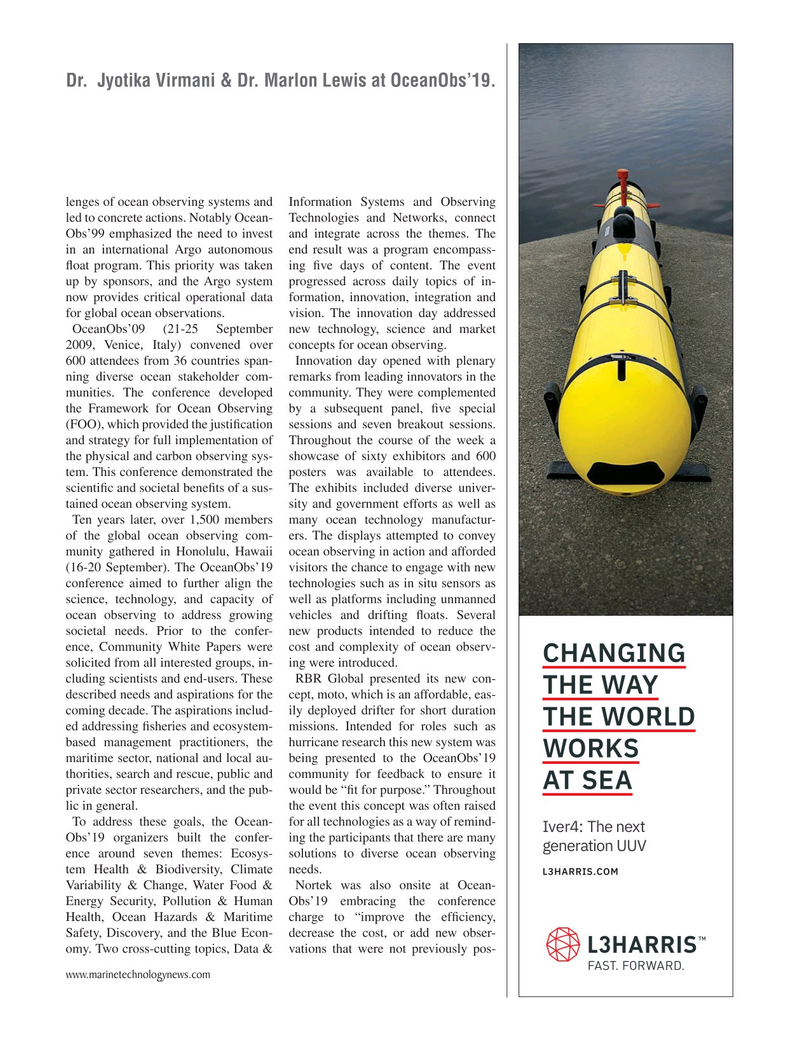
Page 35: of Marine Technology Magazine (October 2019)
Ocean Observation: Gliders, Buoys & Sub-Surface Networks
Read this page in Pdf, Flash or Html5 edition of October 2019 Marine Technology Magazine
Dr. Jyotika Virmani & Dr. Marlon Lewis at OceanObs’19. lenges of ocean observing systems and Information Systems and Observing led to concrete actions. Notably Ocean- Technologies and Networks, connect
Obs’99 emphasized the need to invest and integrate across the themes. The in an international Argo autonomous end result was a program encompass- ? oat program. This priority was taken ing ? ve days of content. The event up by sponsors, and the Argo system progressed across daily topics of in- now provides critical operational data formation, innovation, integration and for global ocean observations. vision. The innovation day addressed
OceanObs’09 (21-25 September new technology, science and market 2009, Venice, Italy) convened over concepts for ocean observing.
600 attendees from 36 countries span- Innovation day opened with plenary ning diverse ocean stakeholder com- remarks from leading innovators in the munities. The conference developed community. They were complemented the Framework for Ocean Observing by a subsequent panel, ? ve special (FOO), which provided the justi? cation sessions and seven breakout sessions. and strategy for full implementation of Throughout the course of the week a the physical and carbon observing sys- showcase of sixty exhibitors and 600 tem. This conference demonstrated the posters was available to attendees. scienti? c and societal bene? ts of a sus- The exhibits included diverse univer- tained ocean observing system. sity and government efforts as well as
Ten years later, over 1,500 members many ocean technology manufactur- of the global ocean observing com- ers. The displays attempted to convey munity gathered in Honolulu, Hawaii ocean observing in action and afforded (16-20 September). The OceanObs’19 visitors the chance to engage with new conference aimed to further align the technologies such as in situ sensors as science, technology, and capacity of well as platforms including unmanned ocean observing to address growing vehicles and drifting ? oats. Several societal needs. Prior to the confer- new products intended to reduce the ence, Community White Papers were cost and complexity of ocean observ-
CHANGING solicited from all interested groups, in- ing were introduced.
cluding scientists and end-users. These RBR Global presented its new con-
THE WAY described needs and aspirations for the cept, moto, which is an affordable, eas- coming decade. The aspirations includ- ily deployed drifter for short duration
THE WORLD ed addressing ? sheries and ecosystem- missions. Intended for roles such as based management practitioners, the hurricane research this new system was
WORKS maritime sector, national and local au- being presented to the OceanObs’19 thorities, search and rescue, public and community for feedback to ensure it
AT SEA private sector researchers, and the pub- would be “? t for purpose.” Throughout lic in general. the event this concept was often raised
To address these goals, the Ocean- for all technologies as a way of remind-
Iver4: The next
Obs’19 organizers built the confer- ing the participants that there are many generation UUV ence around seven themes: Ecosys- solutions to diverse ocean observing tem Health & Biodiversity, Climate needs.
L3HARRIS.COM
Variability & Change, Water Food & Nortek was also onsite at Ocean-
Energy Security, Pollution & Human Obs’19 embracing the conference
Health, Ocean Hazards & Maritime charge to “improve the ef? ciency,
Safety, Discovery, and the Blue Econ- decrease the cost, or add new obser- omy. Two cross-cutting topics, Data & vations that were not previously pos- www.marinetechnologynews.com
MTR #8 (34-49).indd 35 10/8/2019 9:08:05 AM

 34
34

 36
36
